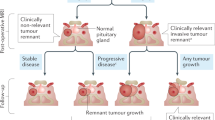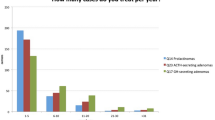Abstract
Clinically nonfunctioning pituitary tumors are common in tertiary endocrine practice. Although it is widely accepted that patients with these adenomas require long-term surveillance after surgery—particularly those with macroadenomas, which grow much more frequently than microadenomas—a consensus on postoperative monitoring and treatment strategies is lacking. The indications for radiotherapy, which has seen a decline in use over the past decade, are not clear, although most experts would agree that residual tumor mass after surgery, as well as tumor expansion into the cavernous sinus, indicate the need to consider postoperative radiotherapy. In patients not treated with radiotherapy after surgical treatment of a nonfunctioning adenoma, MRI of the tumor should be performed annually for the first 6 years and every 2 years thereafter. In addition, silent adrenocorticotropic hormone-secreting tumors can behave more aggressively if they recur, and tumor regrowth can also occasionally be found in patients after classical pituitary apoplexy, which suggests that individuals with these conditions should also be monitored carefully after surgery. However, at which point this scanning routine can be ceased remains the subject of debate, as few data on late recurrence of nonfunctioning pituitary adenomas exist.
This is a preview of subscription content, access via your institution
Access options
Subscribe to this journal
Receive 12 print issues and online access
$209.00 per year
only $17.42 per issue
Buy this article
- Purchase on Springer Link
- Instant access to full article PDF
Prices may be subject to local taxes which are calculated during checkout

Similar content being viewed by others
References
Karavitaki, N. et al. What is the natural history of nonoperated nonfunctioning pituitary adenomas? Clin. Endocrinol. (Oxf.) 67, 938–943 (2007).
Sanno, N., Oyama, K., Tahara, S., Teramoto, A. & Kato, Y. A survey of pituitary incidentaloma in Japan. Eur. J. Endocrinol. 149, 123–127 (2003).
Molitch, M. E. Nonfunctioning pituitary tumors and pituitary incidentalomas. Endocrinol. Metab. Clin. North Am. 37, 151–171 (2008).
Bradley, K. J., Wass, J. A. H. & Turner, H. E. Non-functioning pituitary adenomas with positive immunoreactivity for ACTH behave more aggressively than ACTH immunonegative tumours but do not recur more frequently. Clin. Endocrinol. (Oxf.) 58, 59–64 (2003).
Scheithauer, B. W. et al. Clinically silent corticotroph tumors of the pituitary gland. Neurosurgery 47, 723–729; discussion 729–730 (2000).
Pal, A. et al. Recurrence rates in patients with non-functioning pituitary adenomas presenting with acute apoplexy: a long-term follow-up study. Endocrine Abstracts 21, P275 (2010).
Ahmed, S., Elsheikh, M., Page, R. C., Adams, C. B. & Wass, J. A. H. Outcome of transphenoidal surgery for acromegaly and its relationship to surgical experience. Clin. Endocrinol. (Oxf.) 50, 561–556 (1999).
Marazuela, M. et al. Recovery of visual and endocrine function following transsphenoidal surgery of large nonfunctioning pituitary adenomas. Endocrinol. Invest. 17, 703–707 (1994).
Turner, H. & Wass, J. A. H. Oxford Handbook of Endocrinology and Diabetes 86–212 (Oxford University Press, Oxford, 2009).
Woollons, A. C. et al. Non-functioning pituitary adenomas: indications for postoperative radiotherapy. Clin. Endocrinol. (Oxf.) 53, 713–717 (2000).
O'Sullivan, E. P. et al. The natural history of surgically treated but radiotherapy-naïve nonfunctioning pituitary adenomas. Clin. Endocrinol. (Oxf.) 71, 709–714 (2009).
Gittoes, N. J. et al. Radiotherapy for non-function pituitary tumours. Clin. Endocrinol. (Oxf.) 48, 331–337 (1998).
Rajasekaran, S. et al. UK guidelines for the management of pituitary apoplexy. Clin. Endocrinol. (Oxf.) 74, 9–20 (2011).
Harris, P. E. et al. The effects of transsphenoidal surgery on endocrine function and visual fields in patients with functionless pituitary tumours. Q. J. Med. 71, 417–427 (1989).
Dekkers, O. M. et al. Progressive improvement of impaired visual acuity during the first year after transsphenoidal surgery for non-functioning pituitary macroadenoma. Pituitary 10, 61–65 (2007).
Arnold, J. R., Arnold, D. F., Marland, A., Karavitaki, N. & Wass, J. A. GH replacement in patients with non-functioning pituitary adenoma (NFA) treated solely by surgery is not associated with increased risk of tumour recurrence. Clin. Endocrinol. (Oxf.) 70, 435–438 (2009).
Plowman, P. N. in Oxford Textbook of Endocrinology and Diabetes 1st edn Ch. 2.3.9 (eds Wass, J. A. H. & Shalet, S. M.) 168–172 (Oxford University Press, Oxford, 2002).
Allen, K. V. & Wass, J. A. H. Prolonged post-operative follow-up is necessary for unirradiated non-functioning pituitary adenomata. Endocrine Abstracts 11, P638 (2006).
Wass, J. A. H., Turner, H. E. & Adams, C. B. The importance of locating a good pituitary surgeon. Pituitary 2, 51–54 (1999).
Reddy, G. R. et al. Can we ever stop imaging in surgically treated and radiotherapy naive patients with non-functioning pituitary adenoma? Endocrine Abstracts 21, P294 (2010).
Soto-Ares, G. et al. MRI protocol technique in the optimal therapeutic strategy of non-functioning pituitary adenomas. Eur. J. Endocrinol. 146, 179–186 (2002).
Greenman, Y. et al. Postoperative surveillance of clinically nonfunctioning pituitary macroadenomas: markers of tumour quiescence and regrowth. Clin. Endocrinol. (Oxf.) 58, 763–769 (2003).
Dekkers, O. M. et al. Observation alone after transsphenoidal surgery for nonfunctioning pituitary macroadenoma. J. Clin. Endocrinol. Metab. 91, 1796–1801 (2006).
Ferrante, E. et al. Non-functioning pituitary adenoma database: a useful resource to improve the clinical management of pituitary tumors. Eur. J. Endocrinol. 155, 823–829 (2006).
Van den Bergh, A. C. M. et al. Immediate postoperative radiotherapy in residual nonfunctioning pituitary adenoma: beneficial effect on local control without additional negative impact on pituitary function and life expectancy. Int. J. Radiat. Oncol. Biol. Phys. 67, 863–869 (2007).
Author information
Authors and Affiliations
Contributions
All authors researched the data for the article, provided substantial contributions to discussions of the content, wrote the article and reviewed and/or edited the manuscript before submission.
Corresponding author
Ethics declarations
Competing interests
The authors declare no competing financial interests.
Rights and permissions
About this article
Cite this article
Wass, J., Reddy, R. & Karavitaki, N. The postoperative monitoring of nonfunctioning pituitary adenomas. Nat Rev Endocrinol 7, 431–434 (2011). https://doi.org/10.1038/nrendo.2011.54
Published:
Issue Date:
DOI: https://doi.org/10.1038/nrendo.2011.54
This article is cited by
-
Liquid Biopsy in Low-Grade Glioma: A Systematic Review and a Proposal for a Clinical Utility Score
Cellular and Molecular Neurobiology (2023)
-
Non-functioning pituitary adenomas: indications for pituitary surgery and post-surgical management
Pituitary (2019)
-
Non-invasive radiomics approach potentially predicts non-functioning pituitary adenomas subtypes before surgery
European Radiology (2018)
-
Dopamine agonist therapy induces significant recovery of HPA axis function in prolactinomas independent of tumor size: a large single center experience
Endocrine (2016)
-
Recovery rate of adrenal function after surgery in patients with acromegaly is higher than in those with non-functioning pituitary tumors: a large single center study
Pituitary (2015)



